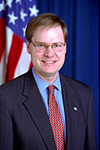
- Afghanistan
- Africa
- Budget Management
- Defense
- Economy
- Education
- Energy
- Environment
- Global Diplomacy
- Health Care
- Homeland Security
- Immigration
- International Trade
- Iraq
- Judicial Nominations
- Middle East
- National Security
- Veterans
- President's Cabinet
- USA Freedom Corps
- Faith-Based & Community Initiatives
- Office of Management and Budget
- National Security Council
- USA.gov
|
Welcome to "Ask the White House" -- an online interactive forum where you can submit questions to Administration officials and friends of the White House. Visit the "Ask the White House" archives to read other discussions with White House officials.
|
|
|
June 24, 2004
Richard Russell Thank you for joining me on Ask the Whitehouse -- I look forward to answering your questions. Tom, from TX writes: Richard Russell The President will view demonstrations of broadband and wireless technologies and deliver remarks on innovation. Dr. Craig Sable of Children's National Medical Center will demonstrate the center's pediatric tele-cardiography program. Simulating a patient in a rural hospital or clinic, Dr. Sable will diagnose a child at Children's hospital by remotely reviewing a patient's echocardiogram (ultrasound of the heart). Using broadband, Dr. Sable can simultaneously monitor the patient's echocardiogram, direct the technician on site to operate the device and talk to the referring physician, patient and mother. The technology enables accurate and instantaneous diagnosis, prevention of emergency transportation of healthy patients to Children's while ensuring that serious problems are identified and treated immediately. Michael Gallagher, Acting Assistant Secretary of Commerce for Communications and Information at the U.S. Department of Commerce, will demonstrate various wireless and broadband technologies: a video phone which uses the Internet or what is known as Voice over Internet Protocol (VoIP); mobile wireless broadband technology on a laptop computer; special electrical plugs which allow consumers to receive broadband transmitted through power lines, from any outlet in their home; and household monitoring cameras and sensors that can use broadband to remotely alert homeowners to problems ranging from burglars to water in their basement. Raul Fernandez, Chairman and CEO of ObjectVideo, will provide a demonstration of VEW, a video surveillance software product. ObjectVideo personnel will stage a mock attack on a power generator located behind ObjectVideo's offices in Reston, VA. The demonstration will show the power of this intelligent video surveillance technology, which can distinguish humans, vehicles and objects left behind, together with the ability of broadband to relay information from a remote site to a central command location, in this case the room in which the demonstration takes place. Because of the speed of broadband, and the ability of the software to provide only information that is necessary to assess the threat potential, the security professional is provided the ability to take action against the threat in real time. Nancy Sturm with the Center for Educational Technologies will demonstrate how distance learning programs are allowing rural students access to improved educational opportunities. Students at Southern Columbia High School in Catawissa, a town of 1700 people in northern Pennsylvania, will be connected to a simulated NASA center at Wheeling Jesuit University, in West Virginia to participate in a simulated space mission during which time they will conduct scientific experiments and solve mathematical problems in real time.
The simulated mission uses broadband Internet connection to create a live link between the students and the simulated mission. The school is part of a partnership of 280 rural schools that leveraged an initial USDA grant for $500,000 from USDA's Distance Learning and Telemedicine program with $12.5 million in state and federal monies. MaryElizabeth, from Denver writes: Richard Russell The President's vision for space exploration is that of "a journey, not a race," a concept that differs profoundly from the Apollo paradigm of a single massive project requiring a large budget spike and a demanding schedule.
The new vision calls for an affordable and long term, sustainable, effort to achieve access to space, and in the President’s words: “…extend the human presence across our solar system, making steady progress one mission, one voyage, one landing at a time." jack, from rhode island
writes: Richard Russell David, from Oakland writes: Richard Russell Numerous products resulting from nanotechnology advances are already on the market. Everything from tennis rackets that incorporate carbon nanotubes to self-cleaning windows that use nanocoatings.
The Administration is working not only on new nano-based technological advances, but also on the implications of nanotechnology on human health and the environment to ensure that the technology is developed responsibly. Ed, from Washington, D.C.
writes: Richard Russell
This also emphasizes the power of a prize. The Administration recognizes this, and has requested $20 million in the Fiscal Year 2005 NASA budget in prize money to spur nontraditional ideas and innovative thinking. Peter, from Lansing, MI writes: Richard Russell Energy, and his plans to enable pollution-free hydrogen-powered vehicles to become a commercial reality; health care information technology, to provide more cost-effective and higher-quality health care for the American people; and broadband. In addition to the policies he outlined today, the President has also committed to funding research and development. The President has made an historic commitment to research and development funding. He has requested $132 billion in research and development funding for Fiscal Year 2005.
This total represents more than the rest of the G8 countries combined. Included in this total is funding for priority areas like nanotechnology and information technology. Cynthia, from Fairfax, VA
writes: Richard Russell Shirlee, from USA writes: Richard Russell Mike, from Mt. Hood
writes: Richard Russell However, as the president has stated, the US shouldn't be 10th in anything, and he is committed to making broadband universally available throughout the US by 2007.
Richard Russell |




